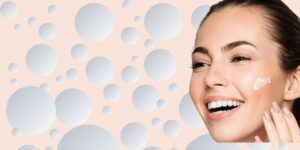Introduction
The skin is the largest and outermost organ in the human body and provides protection for the body from the outside environment. Part of that protection involves protection from the oxidative stress from UV-induced radiation which causes tissue damage and premature skin aging. Anti-oxidant components contained within the skin are responsible for the skin’s anti-oxidant defence1.
“Several in vivo and in vitro studies suggest that green tea supplementation increases the collagen and elastin fiber content, and suppresses collagen degrading enzyme MMP-3 production in the skin, conferring an anti-wrinkle effect.”2
Tea is one of the most widely consumed beverages worldwide, and is available in various forms. Green tea is richer in antioxidants compared to other forms of tea. Tea is composed of polyphenols, caffeine, minerals, and trace amounts of vitamins, amino acids, and carbohydrates2. Green tea is a potent source of anti-oxidant compounds which are capable of defending the skin against the damage caused by action of UV radiation2.
Skin Benefits of Green Tea Application
“The outcome of the several experimental studies suggests that green tea possess anti-inflammatory and anticarcinogenic potential, which can be exploited against a variety of skin disorders.”3
The following is a list of some of the known skincare benefits provided by topical application of green tea:
Anti-aging Activity – Collagen Protection
Green tea components have strong anti-oxidant activity and can eliminate the action of free radicals in damaging the skin. UVA radiation induced free radicals can cause clinical, biochemical and histological changes in the skin through changes in cells and in extracellular matrix proteins, including collagen, responsible for the structural integrity of the skin. These changes cause premature skin aging and can lead to increased risk of skin cancer. The natural aging of the skin associated with the action of free radicals causes a reduction in skin hydration, pigmentation, fine wrinkles. Another change is the reduction of dermal collagen that makes the skin thinner. Green tea polyphenols protect against many of the other damaging effects of UV radiation such as UV-induced sunburn response, UV-induced immunosuppression and photoaging of the skin.4,5
UV Radiation Protection
Green tea compounds are highly UV protective, probably by suppressing the carcinogenic activity of UV radiation and many other damaging effects6. Their photoprotective nature is caused by various cellular, molecular, and biochemical mechanisms. Green tea also provides protection against dangerous effects of UV when merely topically applied on human skin, suggesting a promising role of GTPs as future agents in sunscreen protection6.
“These in vivo observations suggest that green teas is photoprotective, and can be used as pharmacological agent for the prevention of solar UVB light-induced skin disorders associated with immune suppression and DNA damage”.7
Anti-pigmentation Effects
Green tea extract inhibited melanin accumulation and melanin synthesis along with tyrosinase activity in a concentration-dependent manner8. These inhibitory effects were superior to those of arbutin, a well-known depigmenting agent.
“Thus, green tea extracts could be useful skin-whitening agents in the cosmetic industry.”8
Acne Treatment
Polyphenols in green tea have antimicrobial, anti-inflammatory, and antineoplastic properties. Recent studies suggest that tea polyphenols may be used for reducing sebum productionin the skin and for treatment of acne vulgaris.9
Anti-Cancer Effects
“The outcome of the several experimental studies suggests that green tea possess anti-inflammatory and anticarcinogenic potential, which can be exploited against a variety of skin disorders.”3
A number of studies have looked at the anti-cancer properties of green tea3,10. Green tea polyphenols have the greatest effect with respect to chemoprevention and have been found to be most potent at suppressing the carcinogenic activity of UV radiation4. These studies suggest compounds found in green tea have cancer preventive properties but there is a need for more research to clarify these effects10.
Sunscreen Enhancement Effects
“Supplementation of skin care products or sunscreens with green tea may prevent suppression of immune system and procarcinogenic DNA damage.”7
Green tea also provides protection against dangerous effects of UV when merely topically applied on human skin, suggesting a promising role of green tea as a future agent in sunscreen protection4,6,7.
Discussion
“Ferulic acid is a potent antioxidant compound that can be used for the treatment of skin damages. However, the great instability of this active compound led to a reduction of its use from skin care industries.”
Many studies are very promising and suggest the use of green tea as an effective therapeutic option in chronic, infectious, inflammatory, and hair disorders as well as a preventive tool not only against skin aging but also skin cancer6. However, to date there are only a few studies on the use of green tea extracts with double-blind, randomized approaches and large patient numbers.
Green Tea in Cosmetic Formulation
“Green tea polyphenols thus have the potential, when used in conjunction with traditional sunscreens, to further protect the skin against the adverse effects of ultraviolet radiation.”4
Using nano-encapsulation formulation techniques such as microemulsions provide the means to fully utilise and even enhance the powerful anti-oxidant properties of green tea in topical application. Our Vitamin C Serum and our C E Ferulic Serum contain both green tea extract in a microemulsion based formulation. Our nano-encapsulated Green Micelle™ formulations increase formulation stability of green tea and enhance skin permeation for active ingredients for superior UV anti-aging protection.
“Increased attention has been paid to nanomedicine as a method of applying antioxidants topically”.1
References
- 1.Aljuffali I, Hsu C, Lin Y, Fang J. Cutaneous delivery of natural antioxidants: the enhancement approaches. Curr Pharm Des. 2015;21(20):2745-2757. doi:10.2174/1381612821666150428125428
- 2.Prasanth M, Sivamaruthi B, Chaiyasut C, Tencomnao T. A Review of the Role of Green Tea (Camellia sinensis) in Antiphotoaging, Stress Resistance, Neuroprotection, and Autophagy. Nutrients. 2019;11(2). doi:10.3390/nu11020474
- 3.Katiyar S, Ahmad N, Mukhtar H. Green tea and skin. Arch Dermatol. 2000;136(8):989-994. doi:10.1001/archderm.136.8.989
- 4.Yusuf N, Irby C, Katiyar S, Elmets C. Photoprotective effects of green tea polyphenols. Photodermatol Photoimmunol Photomed. 2007;23(1):48-56. doi:10.1111/j.1600-0781.2007.00262.x
- 5.Roh E, Kim J, Kwon J, et al. Molecular mechanisms of green tea polyphenols with protective effects against skin photoaging. Crit Rev Food Sci Nutr. 2017;57(8):1631-1637. doi:10.1080/10408398.2014.1003365
- 6.Zink A, Traidl-Hoffmann C. Green tea in dermatology – myths and facts. JDDG: Journal der Deutschen Dermatologischen Gesellschaft. Published online July 14, 2015:768-775. doi:10.1111/ddg.12737
- 7.Katiyar S, Bergamo B, Vyalil P, Elmets C. Green tea polyphenols: DNA photodamage and photoimmunology. J Photochem Photobiol B. 2001;65(2-3):109-114. doi:10.1016/s1011-1344(01)00248-2
- 8.Kim YC, Choi SY, Park EY. Anti-melanogenic effects of black, green, and white tea extracts on immortalized melanocytes. J Vet Sci. Published online 2015:135. doi:10.4142/jvs.2015.16.2.135
- 9.Saric S, Notay M, Sivamani R. Green Tea and Other Tea Polyphenols: Effects on Sebum Production and Acne Vulgaris. Antioxidants (Basel). 2016;6(1). doi:10.3390/antiox6010002
- 10.Hayakawa S, Ohishi T, Miyoshi N, Oishi Y, Nakamura Y, Isemura M. Anti-Cancer Effects of Green Tea Epigallocatchin-3-Gallate and Coffee Chlorogenic Acid. Molecules. 2020;25(19). doi:10.3390/molecules25194553












